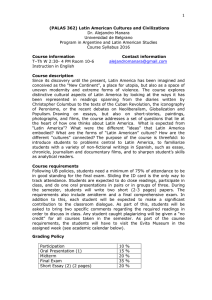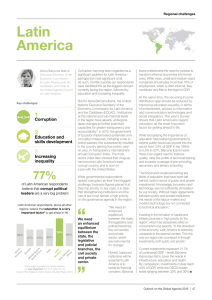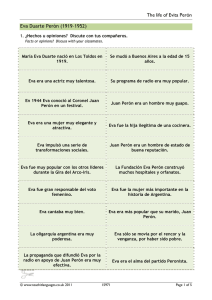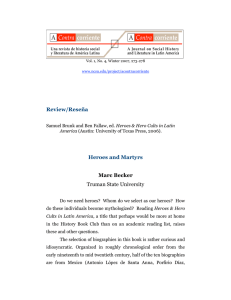(PALAS 362) Latin American Cultures and Civilizations MA Edgardo
Anuncio
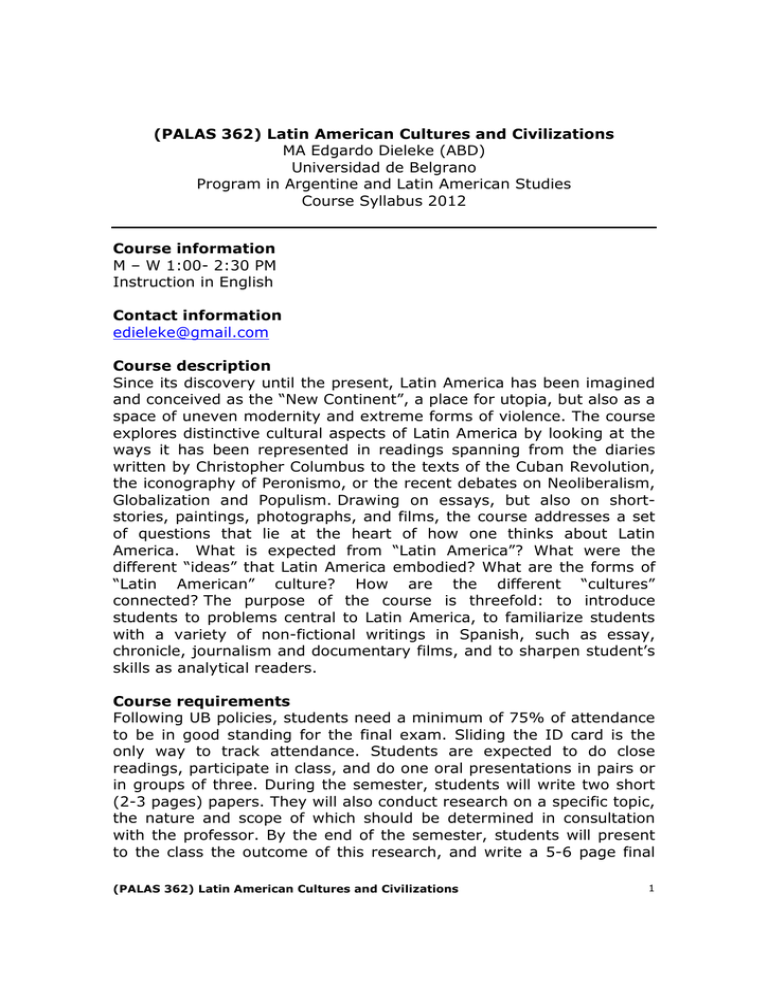
(PALAS 362) Latin American Cultures and Civilizations MA Edgardo Dieleke (ABD) Universidad de Belgrano Program in Argentine and Latin American Studies Course Syllabus 2012 Course information M – W 1:00- 2:30 PM Instruction in English Contact information edieleke@gmail.com Course description Since its discovery until the present, Latin America has been imagined and conceived as the “New Continent”, a place for utopia, but also as a space of uneven modernity and extreme forms of violence. The course explores distinctive cultural aspects of Latin America by looking at the ways it has been represented in readings spanning from the diaries written by Christopher Columbus to the texts of the Cuban Revolution, the iconography of Peronismo, or the recent debates on Neoliberalism, Globalization and Populism. Drawing on essays, but also on shortstories, paintings, photographs, and films, the course addresses a set of questions that lie at the heart of how one thinks about Latin America. What is expected from “Latin America”? What were the different “ideas” that Latin America embodied? What are the forms of “Latin American” culture? How are the different “cultures” connected? The purpose of the course is threefold: to introduce students to problems central to Latin America, to familiarize students with a variety of non-fictional writings in Spanish, such as essay, chronicle, journalism and documentary films, and to sharpen student’s skills as analytical readers. Course requirements Following UB policies, students need a minimum of 75% of attendance to be in good standing for the final exam. Sliding the ID card is the only way to track attendance. Students are expected to do close readings, participate in class, and do one oral presentations in pairs or in groups of three. During the semester, students will write two short (2-3 pages) papers. They will also conduct research on a specific topic, the nature and scope of which should be determined in consultation with the professor. By the end of the semester, students will present to the class the outcome of this research, and write a 5-6 page final (PALAS 362) Latin American Cultures and Civilizations 1 paper due the week before the final exam. The requirements also include a midterm and a final comprehensive exam. As part of the course requirements, the students will have to visit on their own the Evita and the ESMA museums (see academic calendar below). In addition to this, each student will be expected to make a significant contribution to the classroom dialogue. Any student caught plagiarizing will be given a “no credit” for all courses taken in the semester. Grading Policy Participation Oral Presentation (1) Midterm Final Exam Short Essay (2) (2 pages) Final Paper (6-8 pages) 10 10 20 20 20 20 % % % % % % For a better understanding of the comparable table for grading: check the conversion table for the numerical scale (in orientation kit packet) Unit 1. “Discovering the New Continent”: Early Images of Latin America Monday, March 12 Course introduction: The ideas of America Amerigo Vespucci: “The New World” Wednesday, March 14 Great pre-Columbian civilizations (chapters from the Popol Vuh: The Sacred Book of the Ancient Quiche Maya) Week 2. The “New World”: Tales from the Discovery and the Conquest Monday, March 19 Christopher Columbus. “Letter to Luis de Santangel”/ Excerpts from Columbus Diary “A description of Tupinambá”, Anonymous. Wednesday, March 21 Hernán Cortés. Letters from Mexico (selection) Bernal Díaz del Castillo. The conquest of New Spain (selection). J.H. Elliott. “The Uncertain Impact” (1-27) Oral presentations will be assigned (PALAS 362) Latin American Cultures and Civilizations 2 Week 3. Tales of Conquest, Colonial Encounters and its Consequences M Monday, March 26 Inca Garcilaso de la Vega. The Royal Commentaries of the Incas selection). Bartolomé de las Casas. A short account of the destruction of the indies (selection). Wednesday, March 28 Eduardo Galeano. The open veins of Latin America (selection) Oral presentations: Eduardo Galeano. The open veins of Latin America (selection) Week 4. Revisiting the Conquest Monday, April 2 National Holiday / No class Wednesday, March 28 Werner Herzog. Aguirre, the wrath of God Students have to write the first short paper Unit 2. Founding New Nations and the Idea of Latin America Week 5. Monday, April 9 Homi K. Bhabha. Nation and Narration. “Introduction”. Benedict Anderson. Imagined communities. (Selection) Short Paper is due Wednesday, April 4 Simón Bolivar. “Letter of Jamaica” José Martí “Our America” Oral presentations Week 6. Imagining a Nation/ Civilization and Barbarism Monday, April 16 Domingo F. Sarmiento. Facundo (Selection) José Enrique Rodó. Ariel Oral presentations Wednesday, April 18 Doris Summer. Foundational Fictions (excerpts) María Luisa Bemberg. Camila (screening in class) (PALAS 362) Latin American Cultures and Civilizations 3 Week 7. Re-writing the Foundational Fictions Monday, April 23 José Hernández. Martín Fierro (Selection) Jorge Luis Borges, “Story of the Warrior and the Captive Maiden” Wednesday, April 25 Octavio Paz. “The sons of La Malinche” José Carlos Mariategui. “The problem of the Indian” Oral presentations Unit 3. The Arrival of Masses into Public Life Week 8. The Mexican Revolution and the Cuban Revolution Monday, April 30 National Holiday / No class Wednesday, May 2 Vasconcelos, José. The cosmic race (selection) Juan Rulfo. “We’re very poor” John Reed. “Pancho Villa” (364-71) Carlos Fuentes. “Land and Freedom: The Mexican Revolution” Desmond Rochfort. Mexican Muralists Oral presentation on Mexican Muralists Week 9. Discourses of the Cuban Revolution Monday, May 7 Ernesto Guevara. “Socialism and man in Cuba” Fidel Castro. “History will absolve me” (Selection) “Cuba: Historical exception or vanguard in the anticolonial struggle?” Oral presentation on Che Guevara Wednesday, May 9 Senel Paz. “Don’t tell her that you love me” Walter Salles, Motorcycle Diaries Week 10. The Peronist Movement and the Workers Monday, May 14 James, Daniel. “Peronism and the Argentine Working-class” J.M. Taylor. “The Myth of the Myth (1-9); “The Power of a Woman” (10-19) Wednesday, May 16 Julio Cortázar, “House Taken Over” Rodolfo Walsh, “That Woman” Oral presentation on Rodolfo Walsh (PALAS 362) Latin American Cultures and Civilizations 4 Week 11. The Political Aesthetics of Peronism Monday, May 21 Students have to Visit the Evita Museum and write a short paper Fernando Solanas. The hour of the Furnaces (screening in class) Oral presentation on Solanas Wednesday, May 23 Daniel Santoro. Selection of his paintings Short paper on Evita is due Unit 4. From Dictatorships to Neoliberalism Week 12. Dictatorships in the Southern Cone Monday, May 28 Richard Gillespie. “Montoneros: Soldiers of Perón” (377-385) Andres Di Tella. Montoneros (excerpts) Oral presentation on Montoneros. Wednesday, May 30 The Madwomen at the Plaza de Mayo / Hebe de Bonafini and Matilde Sanchez Visit to the ESMA Museum Patricio Guzmán. The Battle of Chie (film excerpts in class) Oral presentation on Madres de Plaza de Mayo Week 13. Subaltern Identities and New Political Organizations Monday, June 4 Rigoberta Menchú. I, Rigoberta Menchú (Selection) Ejército Zapatista. “Sixth Declaration of the Lacandon Jungle” Oral Presentation on Subcomandante Marcos Wednesday, June 6 Cocacolero by Alejandro Landes (screening in class) Unit 5. Latin America in the 21 Century: The Problems of Globalization Week 14. The year of 2001 in Argentina / Social unrest and Violence Monday, June 11 Ernesto Livon Grossman. Cartoneros Noemi Klein. The Take. Final Paper consultations (PALAS 362) Latin American Cultures and Civilizations 5 Wednesday, June 13 Fernando Meirelles. City of God. Lourdes Portillo. Señorita extraviada Final Paper is due Week 15 Monday, June 18 Final Exam Wednesday, June 20 National Holiday / No class Bibliography (in progress) Brennan, Timothy. “The Nation Longing For Form.” Nation and Narration. Homi K. Bhabha, ed. London: Routledge, 1990. 44-70. Chomsky Aviva et al. The Cuba Reader. Durham: Duke University Press, 2003) Cortázar, Julio. “The Gates of Heaven” (comic). Elliott, J.H. “The Uncertain Impact” The Old World and the New (1429-1650) Cambridge UP, 1970. 1-27 Galeano, Eduardo. Open Veins of Latin America: Five Centuries of the Pillage of a Continent. New York: monthly Review Press, 1977. Gené, Marcela. Un mundo feliz. Imágenes de los trabajadores en el primer peronismo. BA: Fondo/Universidad San Andrés, 2005. Gilbert, Joseph and Timothy Henderson, ed. The Mexico Reader. Durham: Duke University Press, 2002. Halperín Donghi, Tulio. Contemporary History of Latin America Berkeley: University of California Press, 1987. James, Daniel. “Perón and the People.” Resistance and Integration: Peronism and the Argentine Working Class, 1946-1976. Cambridge UP, 1988. 273-95. Kraniauskas, John. “Rodolfo Walsh y Eva Perón: “Esa mujer”. Nuevo Texto Crítico 12: (1993): 105-19. Levine, Robert M & John Crocitti, ed. The Brazil Reader. Durham:Duke University Press, 2003. Martínez, Tomás Eloy. Santa Evita. Trad. Helen Lane. New York: Vintage, 1996. Marysa Navarro. “Evita, una de las primeras desaparecidas políticas de Argentina.” (JSTOR) - - -. “Wonderwoman was Argentine and her Real name was Evita.” Canadian Journal of Latin American & Caribbean Studies 24. London: 1999. 133. Navarro, Marysa, “Evita and the Crisis of 17 October 1945.” Journal of Latin American Studies, 12: 1 (Feb. 1980). Perlongher, Néstor. “Evita Live” My deep dark pain is love. Ed. Winston Leyland. San Francisco: Gay Sunshine Press, 1983. 53-57. Perón, Eva. In My Own Words (La razón de mi vida). (PALAS 362) Latin American Cultures and Civilizations 6 Plotkin, Mariano. “May Day and 17 of October: Political Rituals and Peron´s charisma” and The Fundacion Eva Peron, in Mañana es San Perón: A Cultural History of Peron's Argentina. Delaware: Scholarly Resources, año. 39-82. Plotkin, Viviana. Cuerpo femenino, duelo y nación. Un estudio de Eva Perón como personaje literario. BA: Corregidor, 2003. Rochfort, Desmond. Mexican Muralists: Orozco, Rivera, Siqueiros. San Francisco: Chronicle Books, 1993. Rosano, Susana. Rostros y máscaras de Eva Perón. Imaginario populista y representación. Rosario: Beatriz Viterbo, 2006. - - -. “Apuntes para pensar la obra de Daniel Santoro.” Políticas del sentimiento. 241-54. Santoro Daniel. Manual del niño peronista. BA: La Marca, 2002. Sarlo, Beatriz. La pasión y la excepción. BA: Siglo XXI, 2003. Savigliano, Marta. “Evita: The Globalization of a National Myth” (Jstor) Soria, Claudia. Los cuerpos de Eva: anatomía del deseo femenino. Rosario: Beatriz Viterbo, 2005. Soria, Claudia, Paola Cortés Rocca, and Edgardo Dieleke ed. Políticas del sentimiento: el peronismo y la construcción de la Argentina moderna. BA: Prometeo, 2010. Starn, Orin et al. The Peru Reader . Durham: Duke University Press, 2005. Summer, Doris. Foundational Fictions: The National Romances of Latin America. Berlekeley and Los Angeles: U of California P, 1991. Taylor, J.M. “The Myth of the Myth” and “The Power of a Woman.” Eva Peron: The Myths of a Woman. Oxford: U of Chicago P, 1979. 1-19. (PALAS 362) Latin American Cultures and Civilizations 7
